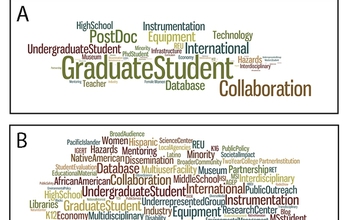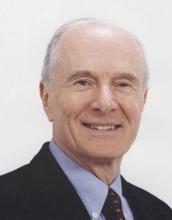All Images
News Release 15-013
NSF@AAAS
NSF staff, fellows and supported scientists present findings and debate policies at prestigious scientific meeting
This material is available primarily for archival purposes. Telephone numbers or other contact information may be out of date; please see current contact information at media contacts.

AAAS Fellows at NSF discuss their findings on broader impacts at the agency. Through text-mining, Justin Lawrence characterized the historical broader impacts portfolio in the NSF Earth Sciences Division (A) and what a more balanced broader impacts portfolio might look like in the future (B).
Credit: Justin Lawrence, AAAS Science & Technology Policy Fellow at NSF
Download the high-resolution JPG version of the image. (270.1 KB)
Use your mouse to right-click (Mac users may need to Ctrl-click) the link above and choose the option that will save the file or target to your computer.

Georgia Tech graduate student Priyanka Rohatgi tests whether the nuclear receptors engineered in yeast cells have the same function in mammalian cells.
Credit: Photo by Gary Meek; courtesy Georgia Tech
Download the high-resolution JPG version of the image. (1.8 MB)
Use your mouse to right-click (Mac users may need to Ctrl-click) the link above and choose the option that will save the file or target to your computer.

At AAAS 2015, researchers and AAAS Fellows discuss results from "Alternative Chemistries of Life--Empirical Approaches", a workshop report sponsored by NSF and NASA.
Credit: NSF, NASA
Download the high-resolution PNG version of the image. (591.2 KB)
Use your mouse to right-click (Mac users may need to Ctrl-click) the link above and choose the option that will save the file or target to your computer.

John Savage, a professor of computer science at Brown University, served as a Jefferson Science Fellow in the U.S. State Department from 2009-10.
Credit: Brown University
Download the high-resolution JPG version of the image. (8.0 KB)
Use your mouse to right-click (Mac users may need to Ctrl-click) the link above and choose the option that will save the file or target to your computer.

In photosynthesis, solar energy is captured and used to produce chemical fuel by a photosynthetic organism. This project is designed to improve the efficiency of this capture and conversion by: 1) separating them into two types of cells: one that captures solar energy and another "factory" cell that produces fuel; and 2) enabling these two different types of cells to communicate with one another via the flow of electrical currents between them. Compartmentalizing the processes of energy capture and fuel production into two different types of cells will allow researchers to optimize environments for each process, and thereby improve the efficiency of each process.
Credit: Credit: Zina Deretsky, NSF
Download the high-resolution JPG version of the image. (238.8 KB)
Use your mouse to right-click (Mac users may need to Ctrl-click) the link above and choose the option that will save the file or target to your computer.

NSF's Wanda Ward leads a session on the role of gender in STEM policy, practice and research at the 2015 AAAS Annual Meeting. Here, an image from the 2013 Gender Summit, which explored gender throughout the scientific enterprise.
Credit: University System of Georgia
Download the high-resolution JPG version of the image. (3.0 MB)
Use your mouse to right-click (Mac users may need to Ctrl-click) the link above and choose the option that will save the file or target to your computer.


